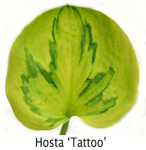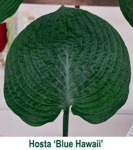|
 We have over 13,700 hosta
names in our database representing around 9,000 to
10,000 different hostas. Many are listed as parentage
"unknown" meaning that nobody kept records of the
ancestry of that plant. For a large number of
open-pollinated seedlings, only the mother i.e. pod
parent has been identified. The mother plant of most sports
is commonly listed regardless of whether it was found in
the garden or generated in the tissue culture process of
propagation. We have over 13,700 hosta
names in our database representing around 9,000 to
10,000 different hostas. Many are listed as parentage
"unknown" meaning that nobody kept records of the
ancestry of that plant. For a large number of
open-pollinated seedlings, only the mother i.e. pod
parent has been identified. The mother plant of most sports
is commonly listed regardless of whether it was found in
the garden or generated in the tissue culture process of
propagation.
 As with most things
associated with hostas, there is a bit of confusion
involved in determining the background of many
cultivars. Hostas listed have been named as either the mother
(pod parent or originator of the sport) or father
(pollen parent) or has been noted as being a plant in
the "background" of the cultivar. We have also included
plants that are listed only as a certain "type" such as
an H. 'Sieboldiana'-type. As with most things
associated with hostas, there is a bit of confusion
involved in determining the background of many
cultivars. Hostas listed have been named as either the mother
(pod parent or originator of the sport) or father
(pollen parent) or has been noted as being a plant in
the "background" of the cultivar. We have also included
plants that are listed only as a certain "type" such as
an H. 'Sieboldiana'-type.
The options listed below
include the numbers
of offspring or background plants associated with
cultivars or species hostas.
|



